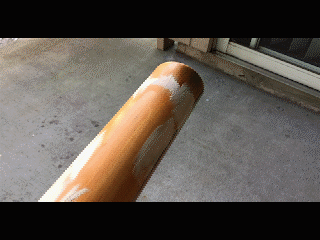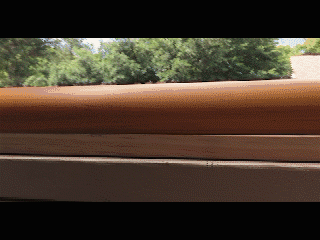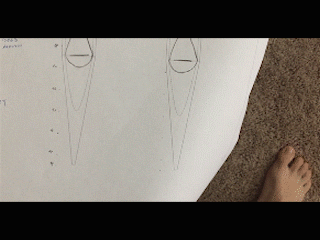Alongside the construction of Opus IV was "pipe art" project with ten (10) of the other pipes. I originally intended to VLOG (Video- Blog) this project. However, due to time constraints, I will blog about it and use a few GIF along with JPEG files for your viewing pleasure.
Since these ten pipes are to be gifts to family, I could not document the process as I went along in real time. So, now that they are all done and given to family, I can now reveal this side project. First, what exactly is this project?
If you recall, these projects started with 25 old fake organ pipes. I restored and used 10 of them within Opus IV. For this project, I will use 10 additional pipes from this set. Each pipe will be painted and decorated according to the person I will be designing the pipe for. They can be hung on the wall and displayed. In order to do this, I needed to plan one side of the pipe (opposite the mouth).
I used a ban saw to do this. However, it was very tricky and most of the pipes needed to be patched up and leveled so they can rest flat on the wall. Wood epoxy came in handy and some shims to repair the cuts that were way off.
After all the pipes were repaired, sanded, sealed and primed, it was time to design each pipe. Instead of going right at it, I decided to print out a scaled blank pipe and use coloured pencils to figure out what design I will paint on each pipe.
Each pipe had a general layout. Two horizontal bars divide the pipe into sections for various designs. These are common for all ten pipes. In order to be somewhat efficient, I decided to paint each pipe their base colours. From there comes the more labour intensive "stenciling."
 |
| 7 original pipe, three more were added later. Mine is in the center. |
The stenciling involved lots of tape, a template, sharp Xacto blade and lots of patience. I ran into some bumps along the way. Most of it was touch ups. Since I'm using spray paint, that became a real pain the further down the road for each pipe. The final touch was gold leaf on the mouth (like Opus IV) as well as horizontal bars capping the horizontal strips. Here are the progression of all 10 pipes.
We shall start with mine. Actually, three in total. For the first one, the base color was an off-white with a light blue (or periwinkle as the spray can named it) accent. The design at the top is Gregorian neumes depicting the word "Gloria" from the setting in the
Miss de angelis. The Maltese Cross represents my family's heritage.
** ACCIDENT **
After leaning this pipe up against the wall, it slid down and hit Opus III!! Thankfully, Opus III was not damaged. Surprised really as this pipe as some weight to it. HOWEVER, The sharp point of the molding put a nice, dime sized gash into this pipe! It should be obvious...I was furious. After calming down, I was able to patch it to the best of my ability. Suffice to say, this pipe just has a little more character.
The two colours of my second pipe consist of a deep red and green with lots of gold leaf spread throughout, including the Maltese cross.
The colors of my third pipe are that same deep red with a dark blue and a touch of that same deep green as my second pipe. I was a little creative with the fleur-de-lis on this pipe. Like the second pipe, I wanted to use the remaining gold leaf I had...so I went for it!
Second is my dads. Primary color is this purple-ish colour. Spray can didn't list a name, but it's almost a dead match for a Fender guitar colour I found online. Secondary colour is an off-white. Appropriately, A Fender guitar and logo appear at the top with the Maltese cross toward the bottom.
Third would be for my close friend, Chris. Opus C, if you recall, was designed for him as well. His design resembles mine. However, Secondary colour is purple and instead of a Maltese Cross, you have the Fleur-de-lis.
 |
| Final residing place |
Fourth and fifth are for my grandparents along with my grandfathers uncle and his wife (My great-great uncle), respectively. Both have a similar design, just different colours.
Sixth and seventh are for my dad's siblings. Both follow a similar design but different colour scheme.
Last but certainly not least, is my sister's pipe. It is her creativity that inspired this pipe art project to begin with. Her's, however, was the most difficult to finish. Primary due to CONSTANT touch ups. Sort of like a, "one step forward, two steps back." However, I'm very happy with the result. As you can see from the progression, some colour's changed mid way.
These ten pipes have been a labour of love. For an amateur, like all that I have done, I continue to impress myself with the creative work that I have completed.
Until next time...























































